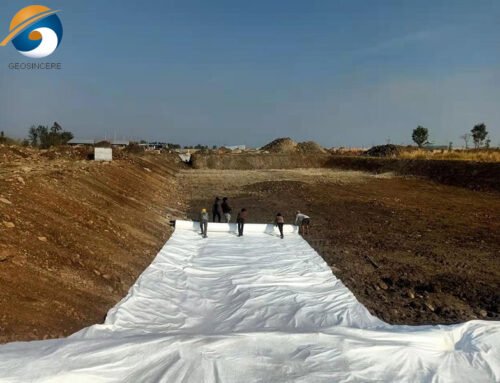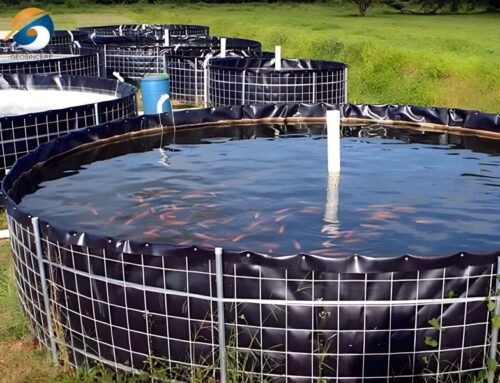In the world of water containment – whether creating a pond, a vital irrigation reservoir, or a large-scale aquaculture operation – one critical component often works unseen beneath the surface: the High-Density Polyethylene (HDPE) Pond Liner. This engineered geomembrane is far more than just a “big sheet of plastic.” It’s a sophisticated barrier designed to provide reliable, long-lasting protection against water loss and environmental contamination. Let’s delve into what High Density Pond Liner, why they excel, and where they prove indispensable.
1.What Exactly is an High Density Pond Liner?
At its core, an HDPE pond liner is a geomembrane fabricated from high-density polyethylene resin. This specific type of plastic is chosen for its exceptional combination of properties crucial for demanding containment applications. The manufacturing process typically involves extruding the molten HDPE resin into flat sheets of varying thicknesses, usually ranging from 0.3 mm (12 mil) to 3.0 mm (120 mil) or even thicker for highly demanding projects. Key characteristics defining HDPE liners include:
1.1 High Density Pond Liner – Unparalleled Impermeability
HDPE actively achieves near-zero liquid penetration with an ultra-low permeability coefficient below 1×10⁻¹³ cm/s. Additionally, its high-density molecular structure creates an impervious barrier against water, chemicals, and leachates. Moreover, this intrinsic property enables reliable long-term containment without degradation or seepage. Consequently, engineers globally specify HDPE as the premier solution for critical water retention and environmental protection projects.
1.2 High Density Pond Liner – Exceptional Durability & Longevity
HDPE liners actively resist punctures from sharp rocks and roots through their high-tensile polymer structure. Additionally, their engineered tear strength withstands abrasion during installation and long-term use without compromising integrity. Moreover, UV-stabilized formulations combined with proper installation techniques enable lifespans surpassing 50 years in harsh environments. Consequently, these liners deliver permanent containment solutions for projects requiring decades of reliable performance.
1.3 High Density Pond Liner- Superior Chemical Resistance
HDPE actively maintains chemical inertness when exposed to aggressive substances like concentrated acids, alkalis, and saline solutions. Additionally, its molecular stability resists degradation from industrial effluents containing hydrocarbons or heavy metals. Moreover, this versatility extends its use beyond simple water containment to complex applications like leachate ponds and chemical storage basins. Consequently, engineers increasingly rely on HDPE for hazardous environments where other materials would rapidly deteriorate.
1.4 High Density Pond Liner – Outstanding UV Resistance
Premium HDPE liners actively incorporate 2-3% carbon black during manufacturing to block harmful UV radiation. Additionally, this additive uniformly disperses throughout the material, providing comprehensive solar protection without weak points. Moreover, UV-stabilized liners maintain mechanical properties after decades of direct sunlight exposure in uncovered installations. Consequently, they outperform standard liners in critical applications like floating covers or exposed landfill caps.
1.5 High Density Pond Liner – Flexibility at Low Temperatures
HDPE liners actively maintain flexibility in sub-zero temperatures, adapting seamlessly to uneven terrain during installation. Additionally, their polymer structure resists brittleness even after repeated freeze-thaw cycles that fracture rigid alternatives. Moreover, this cold-weather durability prevents stress cracks in climates with extreme seasonal shifts. Consequently, Arctic and alpine projects consistently select HDPE for reliable long-term performance in harsh conditions.
1.6 High Density Pond Liner – Environmental Stability
NSF-61 certified HDPE liners actively repel microbial growth like fungi and bacteria without chemical treatments. Additionally, their non-toxic composition prevents plasticizer leaching even during prolonged water contact. Moreover, this biological inertness ensures safe containment for drinking water reservoirs and aquatic habitats. Consequently, regulators and engineers prioritize HDPE for sensitive applications requiring guaranteed material safety.
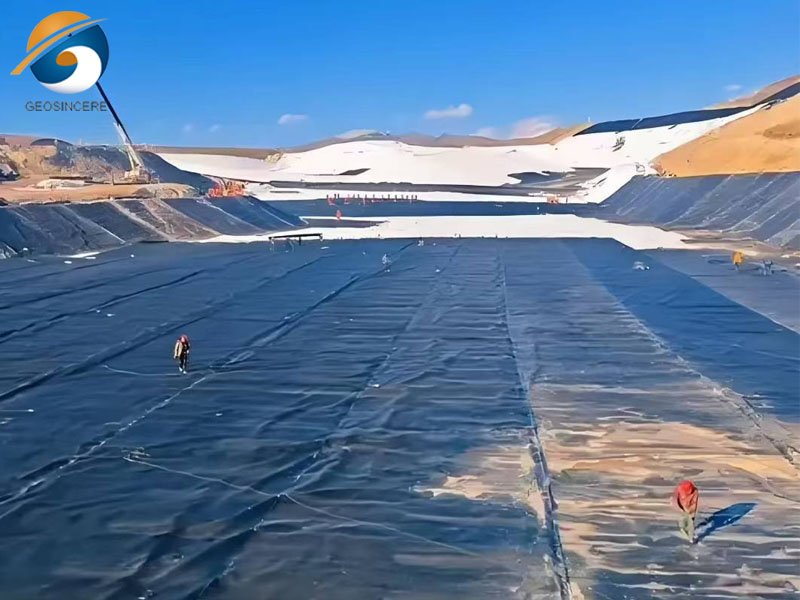

2. How Are They Made? The Science Behind the Sheet
The strength and consistency of HDPE liners come from precise manufacturing:
- Resin Selection: Virgin, high-quality HDPE resin pellets are the starting point. Consistency in the raw material is paramount for performance.
- Additive Incorporation: Key additives are blended with the resin:
- Carbon Black: For essential UV stabilization.
- Antioxidants: To protect against thermal degradation during manufacturing and long-term oxidative degradation in service.
- Stabilizers: For enhanced processing and performance.
- Extrusion: The resin/additive blend is melted and forced through a flat die, creating a continuous molten sheet.
- Calendering & Cooling: The hot sheet passes through precision rollers (calenders) to achieve the exact target thickness and width. It is then rapidly cooled to solidify the material and lock in its structure.
- Quality Control: Rigorous testing occurs throughout manufacturing and on the final product. Tests include thickness checks, tensile strength, tear resistance, puncture resistance, seam peel strength, and carbon black dispersion.
3. The Diverse Landscape of High Density Pond Liner Applications
The unique properties of HDPE liners make them the go-to solution across numerous industries and project scales:
3.1 High Density Pond Liner – Aquaculture & Fish Farming
- Containment: Creating ponds, tanks, and raceways for fish and shrimp farming.
- Bio-Security: Providing a cleanable barrier that helps prevent disease transmission between batches and protects groundwater from waste contamination.
- Water Conservation: Drastically reducing water loss through seepage, a critical factor in sustainable aquaculture.
- Pond Management: Simplifying harvesting and pond bottom cleaning.
3.2 High Density Pond Liner – Agricultural Water Storage
- Irrigation Reservoirs & Ponds: Lining large on-farm storage ponds to maximize water availability for crops and minimize precious water loss.
- Livestock Watering Tanks/Ponds: Providing reliable, leak-proof water sources for cattle, sheep, etc.
- Silt & Sediment Ponds: Containing runoff water and captured sediment on farms.
- Anaerobic Digester Tanks: Containing manure and biogas in agricultural waste treatment systems.
3.3 High Density Pond Liner – Water Features & Landscaping
- Decorative Ponds & Lakes: Creating beautiful, water-tight features in gardens, parks, golf courses, and resorts.
- Koi Ponds: Providing a safe, non-toxic, and durable environment for valuable fish.
- Streams & Waterfalls: Lining artificial watercourses.
- Reflecting Pools: Ensuring pristine water retention for aesthetic purposes.
3.4 High Density Pond Liner – Stormwater & Flood Management
- Detention/Retention Ponds: Lining basins designed to temporarily hold stormwater runoff, controlling flow rates and allowing sediment/pollutant settling before controlled release.
- Infiltration Basins: Lining structures designed to allow clean stormwater to slowly percolate into the ground (liner prevents contaminated water from escaping).
- Secondary Containment: Lining berms and dikes around fuel or chemical storage areas to contain spills.
3.5 High Density Pond Liner – Environmental Protection & Remediation:
- Landfill Liners & Caps: Acting as primary and secondary barriers to prevent leachate (contaminated liquid) from landfills escaping into soil and groundwater, and as caps to prevent rainwater ingress. This is one of the most demanding applications.
- Wastewater Treatment Lagoons: Lining anaerobic and aerobic treatment ponds, sludge drying beds, and equalization basins.
- Contaminated Site Capping: Isolating polluted soil or sediment from the environment.
- Evaporation Ponds: Containing industrial process water, brine, or mining solutions for solar evaporation.
3.6 High Density Pond Liner – Mining & Industrial:
- Heap Leach Pads: Lining pads where ore is piled and leached with chemical solutions to extract minerals.
- Process Solution Ponds: Containing various chemicals and solutions used in mineral extraction or processing.
- Tailings Impoundments: Containing the fine-grained waste material (tailings) from mining operations, a critical application for environmental protection.
- Secondary Containment: Bunding around tanks and drum storage areas.
4. Choosing and Installing High Density Pond Liner: Key Considerations
4.1 Thickness (Gauge):
Thicker liners (e.g., 1.0mm/40mil, 1.5mm/60mil, 2.0mm/80mil) offer greater puncture resistance and longevity, essential for rocky subgrades, large water volumes, heavy equipment traffic (during/after installation), or critical containment (landfills, mining). Thinner liners (e.g., 0.5mm/20mil, 0.75mm/30mil) may suffice for small decorative ponds with smooth, sandy bases.
4.2 Subgrade Preparation:
This is crucial. The ground must be smooth, compacted, and free of sharp rocks, roots, debris, and any protrusions that could puncture the liner. A protective geotextile fabric is often laid underneath the HDPE liner, especially on rocky or uneven subgrades, to cushion and protect it.
4.3 Professional Installation:
While DIY is possible for very small projects, professional installation is highly recommended for anything beyond a tiny garden pond. Proper techniques for unrolling, positioning, field seaming (typically using dual-track hot wedge fusion welding for the strongest, most impermeable bond), anchoring, and protecting the liner are vital for long-term performance and warranty validity. Poor seaming is the most common cause of liner failure.
4.4 Protection:
Once installed, the liner often needs protection from UV exposure if left exposed (though HDPE is UV resistant, prolonged direct exposure can eventually degrade the surface) and physical damage. This is usually achieved by covering it with soil, sand, gravel, rock armor (rip-rap), or concrete, depending on the application.
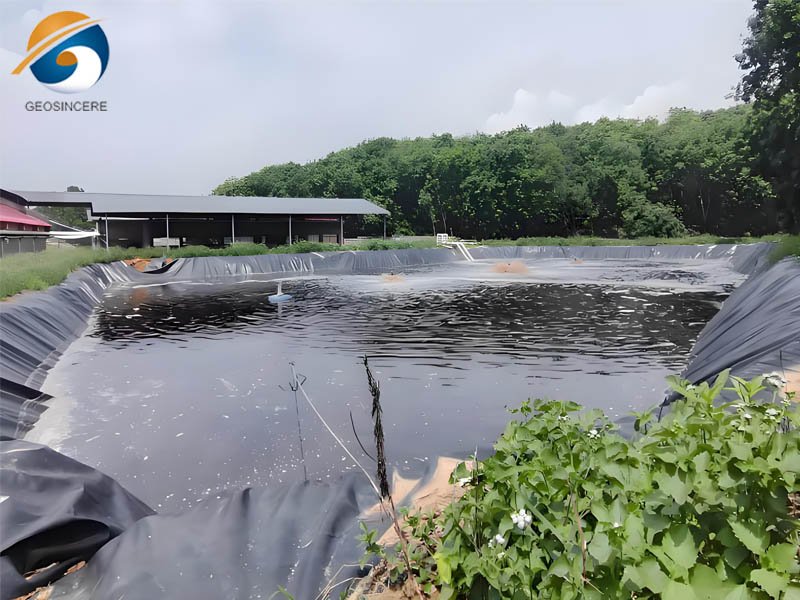
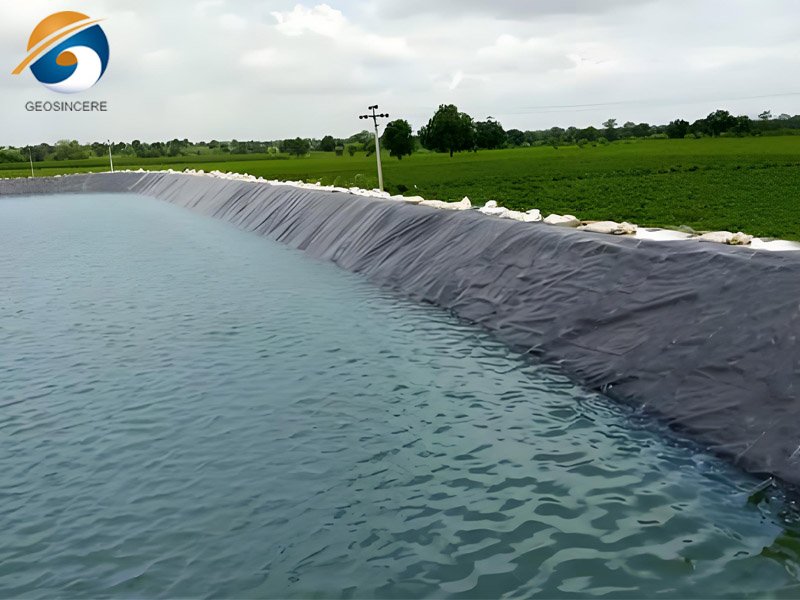
5. Beyond the Basics: Why HDPE Often Wins
Compared to other liner materials like EPDM (rubber), PVC (flexible plastic), or RPP (reinforced polypropylene), HDPE offers a compelling combination:
- Best Chemical Resistance: Superior to EPDM and PVC for harsh chemicals.
- Best Puncture/Tear Resistance: Generally superior to PVC and EPDM, especially in thicker gauges.
- Best UV Resistance: The carbon black stabilization makes it far more UV resistant than standard PVC or EPDM.
- Widest Temperature Range: Performs well in extreme cold and heat.
- Lower Cost per Square Foot (in thicker gauges): While thinner PVC or EPDM might seem cheaper initially, achieving comparable puncture/tear
strength often requires thicker (and thus more expensive) PVC/EPDM than HDPE. HDPE’s longevity also improves lifecycle cost.
6.Conclusion
The High-Density Polyethylene (HDPE) pond liner is a triumph of modern materials engineering. Its remarkable impermeability, durability, chemical resistance, and longevity make it far more than just a pond liner – it’s a fundamental solution for secure water and contaminant containment across a vast spectrum of human activity. From nurturing fish and irrigating crops to protecting groundwater from landfill leachate and managing stormwater, HDPE geomembranes provide the reliable, long-lasting barrier essential for sustainable water management, environmental protection, and successful project outcomes. When water retention or environmental integrity is paramount, HDPE liners stand as a proven, high-performance choice. Choosing the right thickness and ensuring expert installation are key steps to unlocking their full potential for decades of reliable service.If you have any questions about geomembranes, please contact GEOSINCERE.


